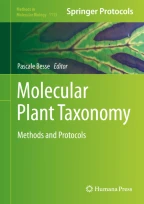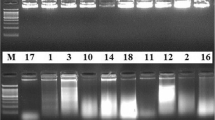Leaf Tissue Sampling and DNA Extraction Protocols

Taxonomists must be familiar with a number of issues in collecting and transporting samples using freezing methods (liquid nitrogen and dry ice), desiccants (silica gel and blotter paper), and preservatives (CTAB, ethanol, and isopropanol), with each method having its own merits and limitations. For most molecular studies, a reasonably good quality and quantity of DNA is required, which can only be obtained using standard DNA extraction protocols. There are many DNA extraction protocols that vary from simple and quick ones that yield low-quality DNA but good enough for routine analyses to the laborious and time-consuming standard methods that usually produce high quality and quantities of DNA. The protocol to be chosen will depend on the quality and quantity of DNA needed, the nature of samples, and the presence of natural substances that may interfere with the extraction and subsequent analysis. The protocol described in this chapter has been tested for extracting DNA from eight species and provided very good quality and quantity of DNA for different applications, including those genotyping methods that use restriction enzymes.
This is a preview of subscription content, log in via an institution to check access.
Access this chapter
Subscribe and save
Springer+ Basic
€32.70 /Month
- Get 10 units per month
- Download Article/Chapter or eBook
- 1 Unit = 1 Article or 1 Chapter
- Cancel anytime
Buy Now
Price includes VAT (France)
eBook EUR 93.08 Price includes VAT (France)
Softcover Book EUR 116.04 Price includes VAT (France)
Hardcover Book EUR 158.24 Price includes VAT (France)
Tax calculation will be finalised at checkout
Purchases are for personal use only
Similar content being viewed by others

Herbarium Specimens: A Treasure for DNA Extraction, an Update
Chapter © 2021

DNA Barcoding for Plants
Chapter © 2015

Extraction of high-quality genomic DNA from different plant orders applying a modified CTAB-based method
Article Open access 12 February 2019
References
- Klimyuk VI, Carroll BJ, Thomas CM, Jones JDG (1993) Alkali treatment for rapid preparation of plant material for reliable PCR analysis. Plant J 3:493–494 ArticleCASPubMedGoogle Scholar
- Clancy JA, Jitkov VA, Han F, Ullrich SE (1996) Barley tissue as direct template for PCR: a practical breeding tool. Mol Breed 2:181–183 ArticleCASGoogle Scholar
- Langridge U, Schwall M, Langridge P (1991) Squashes of plant tissue as substrate for PCR. Nucleic Acids Res 19:6954 ArticleCASPubMed CentralPubMedGoogle Scholar
- Ikeda N, Bautista NS, Yamada T, Kamijima O, Ishii T (2001) Ultra-simple DNA extraction method for marker-assisted selection using microsatellite markers in rice. Plant Mol Biol Report 19:27–32 ArticleCASGoogle Scholar
- Lin JJ, Fleming R, Kuo JMBF, Saunders JA (2000) Detection of plant genes using a rapid, nonorganic DNA purification method. Biotechniques 28:346–350 CASPubMedGoogle Scholar
- Gao S, Martinez C, Skinner DJ, Krivanek AF, Crouch JH, Xu Y (2008) Development of a seed DNA-based genotyping system for marker-assisted selection in maize. Mol Breed 22:477–494 ArticleCASGoogle Scholar
- Marsal G, Baiges I, Canals JM, Zamora F, Fort F (2011) A fast, efficient method for extracting DNA from leaves, stems, and seeds of Vitis vinifera L. Am J Enol Vitic 62:376–381 ArticleCASGoogle Scholar
- Praveen M, Nanna RS (2009) A simple and rapid method for DNA extraction from leaves of tomato, tobacco and rape seed. J Phytol 1:388–390 Google Scholar
- Salim K, Qureshi MI, Kamaluddin, Tanweer A, Abdin MZ (2007) Protocol for isolation of genomic DNA from dry and fresh roots of medicinal plants suitable for RAPD and restriction digestion. Afr J Biotechnol 6:175–178 Google Scholar
- Lin J, Ritland K (1995) Flower petals allow simpler and better isolation of DNA for plant RAPD analyses. Plant Mol Biol Report 13:210–213 ArticleCASGoogle Scholar
- Reddy GM, Coe E (1990) Isolation of nucleic acids from pollen grains. Maize Genet Coop News Lett 1990, 43 Google Scholar
- Chase MW, Hills HH (1991) Silica gel: an ideal material for field preservation of leaf samples for DNA studies. Taxon 40:215–220 ArticleGoogle Scholar
- Botstein D, White RL, Skolnick M, Davis RW (1980) Construction of a genetic linkage map in man using restriction fragment length polymorphisms. Am J Hum Genet 32:314–331 CASPubMed CentralPubMedGoogle Scholar
- Elshire RJ, Glaubitz JC, Sun Q, Poland JA, Kawamoto K, Buckler ES et al (2011) A robust, simple genotyping-by-sequencing (GBS) approach for high diversity species. PLoS ONE 6:e19379 ArticleCASPubMed CentralPubMedGoogle Scholar
- Rogstad SH (1992) Saturated NaCl-CTAB solution as a means of field preservation of leaves for DNA analyses. Taxon 41:701–708 ArticleGoogle Scholar
- Storchova H, Hrdlickova R, Chrtek J Jr, Tetera M, Fitze D, Fehrer J (2000) An improved method of DNA isolation from plants collected in the field and conserved in saturated NaCl/CTAB solution. Taxon 49:79–84 ArticleGoogle Scholar
- Fukatsu T (1999) Acetone preservation: a practical technique for molecular analysis. Mol Ecol 8:1935–1945 ArticleCASPubMedGoogle Scholar
- Flournoy LE, Adams RP, Pandy RN (1996) Interim and archival preservation of plant specimens in alcohols for DNA studies. Biotechniques 20:657–660 CASPubMedGoogle Scholar
- Dubreuil P, Warburton M, Chastanet M, Hoisington D, Charcosset A (2006) More on the introduction of temperate maize into Europe: large-scale bulk SSR genotyping and new historical elements. Maydica 51:281–291 Google Scholar
- Warburton ML, Setimela P, Franco J, Cordova H, Pixley K, Banziger M et al (2010) Toward a cost-effective fingerprinting methodology to distinguish maize open-pollinated varieties. Crop Sci 50:467–477 ArticleGoogle Scholar
- Etten JV, Lopez MRF, Monterroso LGM, Samayoa KMP (2008) Genetic diversity of maize (Zea mays L. ssp. mays) in communities of the western highlands of Guatemala: geographical patterns and processes. Genet Resour Crop Evol 55:303–317 ArticleGoogle Scholar
- Eschholz TW, Peter R, Stamp P, Hund A (2008) Genetic diversity of Swiss maize (Zea mays L. ssp. mays) assessed with individuals and bulks on agarose gels. Genet Resour Crop Evol 55:971–983 ArticleGoogle Scholar
- Reif JC, Hamrit S, Heckenberger M, Schipprack W, Peter MH, Bohn M et al (2005) Genetic structure and diversity of European flint maize populations determined with SSR analyses of individuals and bulks. Theor Appl Genet 111:906–913 ArticleCASPubMedGoogle Scholar
- Michelmore RW, Paran I, Kesseli RV (1991) Identification of markers linked to disease-resistance genes by bulked segregant analysis: a rapid method to detect markers in specific genomic regions by using segregating populations. Proc Natl Acad Sci USA 88:9828–9832 ArticleCASPubMedGoogle Scholar
- Pacek P, Sajantila A, Syvanen AC (1993) Determination of allele frequencies at loci with length polymorphism by quantitative analysis of DNA amplified from pooled samples. PCR Methods Appl 2:313–317 ArticleCASPubMedGoogle Scholar
- Fu YB (2003) Applications of bulking in molecular characterization of plant germplasm: a critical review. Plant Gen Res 1:161–167 ArticleGoogle Scholar
- Wang H, Qi MQ, Cutler AJ (1993) A simple method of preparing plant samples for PCR. Nucleic Acids Res 21:4153–4154 ArticleCASPubMed CentralPubMedGoogle Scholar
- Williams CE, Ronald PC (1994) PCR template-DNA isolated quickly from monocot and dicot leaves without tissue homogenization. Nucleic Acids Res 22:1917–1918 ArticleCASPubMed CentralPubMedGoogle Scholar
- Post RV, Post LV, Dayteg C, Nilsson M, Forster BP, Tuvesson S (2003) A high-throughput DNA extraction method for barley seed. Euphytica 130:255–260 ArticleGoogle Scholar
- Saghai-Maroof MA, Soliman KM, Jorgensen RA, Allard RW (1984) Ribosomal DNA spacer-length polymorphisms in barley: mendelian inheritance, chromosomal location, and population dynamics. Proc Natl Acad Sci 81:8014–8018 ArticleCASPubMedGoogle Scholar
- Murray MG, Thompson WF (1980) Rapid isolation of high molecular weight plant DNA. Nucleic Acids Res 8:4321–4325 ArticleCASPubMed CentralPubMedGoogle Scholar
- Paterson AH, Brubaker CL, Wendel JF (1993) A rapid method for extraction of cotton (Gossypium spp.) genomic DNA suitable for RFLP or PCR analysis. Plant Mol Biol Report 11:122–127 ArticleCASGoogle Scholar
Acknowledgements
This protocol was optimized for the molecular breeding component of the Drought Tolerant Maize for Africa (DTMA) project, which is funded by funded by the Bill and Melinda Gates Foundation. The author would like to thank Veronica Ogugo for testing the protocol in different species.
Author information
Authors and Affiliations
- International Maize and Wheat Improvement Center (CIMMYT), Nairobi, Kenya Kassa Semagn
- Kassa Semagn


